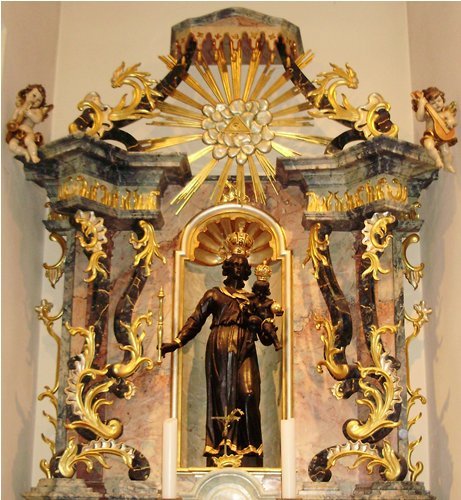Windhausen
Photos: Ella Rozett
The Black Mother of God
Windhausen is a little village across the highway from Herschwiesen, a slightly bigger village with a famous baroque church. Both are part of the city Boppard in the Rhein-Hunsrück region. The chapel is open all day and lays about 15 minutes from the home of another Black Madonna in Beilstein on the Mosel, which is even more worth a visit.
Tradition says that around the year 1775 a local tenant farmer by name of Peter Becker sought relief from a debilitating illness at the feet of the Black Madonna in the Carthusian monastery near Koblenz. When the Queen of Heaven heard his prayers and did indeed heal him, he erected, in thanksgiving, a small chapel in his home village Windhausen and placed in it a Black Madonna similar to the one he had sought out. Several miracles and wonders took place immediately. E.g. a wilted lily in the hand of the Madonna brought forth fresh buds and during a prayer meeting that Peter Becker held with others the statue lit up with a heavenly light. A boy was healed of paralysis, a blind person was given sight, and a girl could leave her crutch at the feet of the Madonna. With that of course so many pilgrims started coming that a bigger chapel was needed, which Mr. Becker promptly provided.
This honeymoon between the divine Mother and her children didn’t remain undisturbed for long. The king had ordered enlightenment and religious equality between Catholics and Protestants. This meant the presence and power of Catholicism had to be reduced and “old time religion” with its “superstitions” was frowned upon. As in other places (see Chartres) Catholic clerics used this as an excuse to curtail grass roots practices they hadn’t dared to forbid before. Now the local bishop prohibited the collection of offerings and the presentation of ex voti in the Windhausen chapel and ordered the Image of Grace to be moved to the parish church in Herschwiesen. But since the chapel and the statue were the private property of Peter Becker, he simply took the Black Madonna into his home.
Shortly thereafter the French occupied the Rheinland and they too wanted to get rid of the holy place in Windhausen. The police chief of Boppard was ordered to take a troop of soldiers and destroy the chapel of the Black Madonna. Having been warned of this danger, the local peasants filled the bigger chapel with hay and straw, pretending to be good, enlightened citizens who had turned a useless chapel into a rational barn. They asked for the “barn” to be saved and consented to the old, outgrown chapel to be razed.
Meanwhile Peter had taken off with the Black Madonna, in search for a good hiding place. He thought of burying her in the forest, but when he began to dig, he uncovered a crucifix in the ground and a spring of fresh water gushed forth from the hole. Later it turned out to be healing water. Next he hid the Madonna in a hollow oak tree, but the oak was struck by lightning and the statue blackened completely. Finally Our Lady was brought to a neighboring village, where the police found her, moved her to Koblenz, whence she disappeared.
Windhausen sign
Under Emperor Napoleon I the enmity between state and church loosened and the “barn” in Windhausen could once more become the chapel it was meant to be. A Mary statue was installed there and painted black in remembrance of the original. With that pilgrimages started up again, even stronger than before.
Peter Becker died in 1806 at age 70, reputed to be a very holy man. His chapel wasn’t officially consecrated by clergy until 1831.
At the end of World War II the chapel was badly damaged, but the Madonna was saved by some neighbors who ended up housing her for three years. The necessary repairs seemed almost impossible to accomplish in the postwar years, but Mother Gipp, the hostess of the Black Madonna, kept urging: “Finish the chapel and my son will come home from the French prison camp where he is held! When the chapel is complete the Mother of God will send him home.”¹ And so it was. The night before the rededication ceremonies Mother Gipp’s son called to say he was in Boppard, almost home. He attended the opening mass the next day.
The postwar repairs were only rudimentary. It took till 1985 for the shrine to be restored to its former glory. Since then pilgrims come once more.
The booklet from which I have taken most of this information quotes a local poet who writes: “…all thoughts and words died in me when I stood before that dark miracle in glowing, sparkling light, of which grandfather and the old mothers in the village had told stories…”² Yes, that indeed is the mystical power of the Black Madonna: to halt our thoughts and concepts long enough so we can experience the divine spark in everything.
Footnotes:
1. The Catholic parish of Herschwiesen, “Pilgerbüchlein zur Schwarzen Muttergottes von Windhausen”, Boppard: 2005, p.12
2. ibid, p.11




